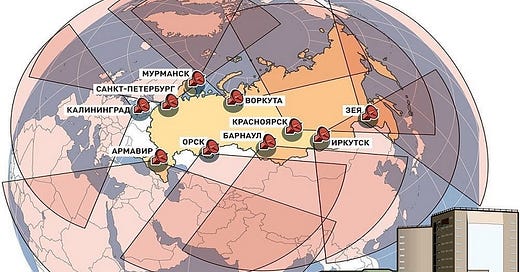Is Ukraine Going Rogue Or Did It Attack Russia’s Early Warning Systems With American Approval?
Russia’s answer to this question will determine its response to any conventional NATO intervention in Ukraine.
Russian-US relations deteriorated further than ever in late May as a result of three developments. First, the US set the ball rolling by more openly allowing Ukraine to use its arms to strike targets inside of Russia, then Poland said that the US will hit all of Russia’s forces in the special operation zone if Moscow uses nukes, and finally, President Putin signaled that he expects NATO to majorly escalate the conflict by sometime this summer. All of this is bad enough, but it’s made even worse by what Ukraine just did.
Russia confirmed that Ukraine hit at least one of its early nuclear warning systems, while Kiev claims to have targeted a second one deeper inside its opponent’s hinterland that hasn’t (yet?) been confirmed. These structures detect incoming intercontinental ballistic missiles of the sort that could be launched by the US in the scenario of a first strike, thus enabling Russia to prepare for an inevitable second strike. They have nothing to do with the Ukrainian Conflict and everything to do with strategic stability.
Both reportedly remain operable, but this nevertheless represents an unprecedented development since never before has any country ever targeted another’s such systems, which could partially blind them to a first strike in the worst-case scenario and thus give the attacking party a huge edge in that event. The further deterioration of Russian-US relations that occurred independently of this development raised tensions to their highest level since the Cuban Missile Crisis so this couldn’t have come at a worse time.
The most important question in the world right now is whether Ukraine is going rogue, perhaps to provoke a crisis like the aforesaid one in the expectation that it could force Russia to withdraw from at least some of the territory that Kiev claims as its own, or if this was done with American approval. The Washington Post’s report about how US officials are concerned about what Ukraine just did lends credence to the first view, but that might just be disinformation for plausible deniability purposes.
At the same time, however, it’s worth remembering how Ukraine defied the US’ public demands not to target Russian oil refineries. The Biden Administration doesn’t want that commodity’s price to spike ahead of the November elections, yet Zelensky still ordered his forces to hit refineries anyhow. That also came amidst the Congressional deadlock over more Ukraine aid that was resolved shortly after those strikes became problematic. It therefore wouldn’t be unprecedented for Ukraine to go rogue yet again.
On top of that, the Financial Times reported that “some Ukrainian officials say (ties with the US) have hit their lowest ebb” due to the abovementioned restrictions on targeting Russian oil refineries and Zelensky’s “paranoia” (as one of their alleged Ukrainian insiders described it) of the US’ intentions. He’s also offended that Biden won’t participate in the upcoming Swiss “peace talks” after snubbing them for a fundraiser, which reportedly prompted him to send a memo ordering officials to criticize the US leader.
Nevertheless, the best approach would arguably be for Russia to assume that America at the very least tacitly approved Ukraine’s strikes on its early warning system(s) since this train of thought aligns with the escalatory trend of the past week. After all, if NATO as a whole or at least a “coalition of the willing” from that bloc commence a conventional intervention in Ukraine, then it could prompt Russia to use tactical nukes in self-defense to stop this invasion force if it crosses the Dnieper and threatens its new regions.
In that event, the US might either conventionally strike all of Russia’s forces in the special operation zone like Poland claimed that it would do, or just cut to the chase by launching a first nuclear strike that could be facilitated by its Ukrainian proxy carrying out more attacks against its early warning systems. There’s also the chance that more such attacks could simply precede a first nuclear strike by the US before any conventional NATO intervention if decisionmakers conclude that an exchange would then be inevitable.
It therefore can’t be ruled out that Ukraine was probing the security of Russia’s early warning systems at the behest of its American patron in preparation of that worst-case scenario, hence the wisdom of Dmitry Suslov’s advice for his country to carry out a “demonstrative” nuclear test. This influential expert from the Russian Council on Foreign and Defense Policy had his policy proposal translated and republished at RT here, which brought it to global attention with the intent of signaling to the US.
Readers might also remember that RT published the proposal by Suslov’s colleague Sergey Karaganov last June where he explained why Russia should nuke Europe in order to deter the US in Ukraine. This latest proposal is much more practical and carries with it no risk of sparking World War III, plus it could represent a fitting finale to Russia’s tactical nuclear weapons exercises that were just carried out. Those were ordered to deter the US, but given its continued escalations, a stronger signal might be needed.
Russia’s answer to the question of whether Ukraine went rogue when attacking its early warning system(s) or if this was done at America’s behest will determine its response to any conventional NATO intervention in Ukraine. The first could see Russia wait until a large-scale force crosses the Dnieper to use tactical nukes, while the second might push it to launch a nuclear first strike against the US before that intervention begins so as to preempt the nuclear first strike that Russia might believe the US is planning.




